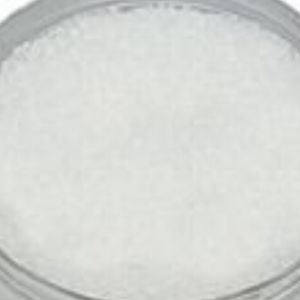
Ph Eur
DEFINITION
Poly(vinyl acetate) is a thermoplastic polymer obtained by polymerisation of vinyl acetate using a suitable starter, without solvent or with water or 2-propanol. The vast majority of the acetate moieties are attached to non-neighbouring carbon atoms of the chain. The index n is about 100 - 17 000. The relative molecular mass lies between 10 000 and 1500 000. The viscosity is 4 to 250 mPas. The ester value, which characterises the degree of hydrolysis, is 615 to 675.
CHARACTERS
Appearance: White or almost white powder or colourless granules or beads.
Solubility: Practically insoluble in water, freely soluble in ethyl acetate, soluble in alcohol. It is hygroscopic and swells in water. It softens at temperatures above 40-50C.
IDENTIFICATION
A. Infrared absorption spectrophotometry. To pass the test.
B. It complies with the test for viscosity (see Tests).
C. Saponify 0.500 g in a mixture of 25.0 ml of 0.5 M alcoholic potassium hydroxide and 25.0 ml of water. The solution obtained gives the reaction of acetates.
TESTS
Solution S: Suspend 50.0 g in 100 ml of ethyl acetate R in a borosilicate glass flask with a ground-glass neck. Heat under a reflux condenser with constant stirring for 30 min. Allow to cool. Filter through a tared sintered glass filter (16) (2.1.2) and wash the residue with 50.0 ml of ethyl acetate, pour the filtrate into a 250 ml graduated flask. Dilute to 250 ml with ethyl acetate.
Appearance of solution: Solution S is clear and colourless.
Viscosity: 85 per cent to 115 per cent of the value stated on the label.
Determine the viscosity immediately after preparation of solution S at 20± 0.1C by using a rolling ball viscosimeter.
Acid value: Maximum 2.0, determined on 5.0 g dissolved in 50 ml of alcohol by shaking for 3 h.
Ester value: 615 to 675.
Saponify 0.500 g in a mixture of 25.0 ml of 0.5 M alcoholic potassium hydroxide and 25.0 ml of water.
Residual peroxides: Maximum 100 ppm, calculated as hydrogen peroxide.
Vinyl acetate: maximum 0.3 per cent to meet the test.
Heavy metals: Maximum 10 ppm.
Loss on drying: Maximum 1.0 per cent, determined on 1.000 g by drying in an oven at 105C.
Sulphated ash: Maximum 0.1 per cent, determined on 1.0 g.
LABELLING
The label states:
the nominal relative molecular mass;
the viscosity.
(C4H6O2 )n
Vinyl acetate homopolymer
Vinyl acetate resin --- 9003-20-7.
UNII: 32K497ZK2U
DEFINITION
Polyvinyl acetate is a thermoplastic polymer, represented by the formula: (C4H6O2 )n in which the value of n lies between approximately 100 and 17,000.
IDENTIFICATION
A. Procedure:
Sample: 100 mg of Polyvinyl Acetate
Analysis: Dissolve the Sample in 2.5 mL of acetone, place two drops on a potassium bromide plate, and dry to evaporate the solvent.
Acceptance criteria: IR absorption spectrum.
B. Procedure:
Sample: 0.5 g of Polyvinyl Acetate
Analysis: Saponify the Sample in a mixture of 25.0 mL of 0.5 N alcoholic potassium hydroxide and 25.0 mL of water.
Acceptance criteria: The solution so obtained meets the requirements of the tests for Acetate.
CAS: [9003-20-7]
DESCRIPTION
Polyvinyl Acetate occurs as a clear, water white to pale yellow, solid resin. It is prepared by the polymerization of vinyl acetate. After completion of polymerization, the resin is freed of traces of residual catalyst (usually a peroxide), monomer, and/or solvent by vacuum drying, steam sparging, washing, or any combination of these treatments. The resin is soluble in acetone, but it is insoluble in water.
REQUIREMENTS
Identification: The infrared absorption spectrum of a melted sample on a potassium bromide plate exhibits relative maxima at the same wavelengths as those of a typical spectrum as shown in the section on Infrared Spectra, using the same test conditions as specified therein.
Free Acetic Acid: Not more than 0.05%.
Lead: Not more than 3 mg/kg.
Loss on Drying: Not more than 1.0%.
Molecular Weight: Not less than 2000.